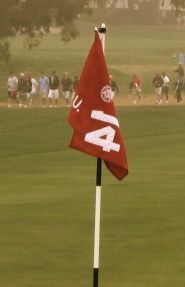"Our rules officials have finally realized that — duh! — course setup has a lot to do with pace of play."
/As always I enjoyed the pre-Open Championship insights from SI's anonymous tour pro (thought it would be nice if he'd actually seen Birkdale!), including this on the relationship between PGA Tour course setup and slow play.
No doubt I'm wasting my time talking about slow play. One veteran told me that we had the same discussions 25 years ago. The Tour is trying to identify the slower players and work with them to get faster, but in the end we're probably only talking about picking up 15 minutes a round. Is that a big deal? Probably not.Yes it is!
One thing I like is that the Tour is going to use ShotLink to tell us how long we take for each shot. Certain players who are slow and don't know the average time spent on a particular shot need to be made aware. Our rules officials have finally realized that — duh! — course setup has a lot to do with pace of play. It's not only the players who are slow. When you play a 510-yard par-4 with a semi-island green, you're going to take a while. It seems obvious, but apparently our officials didn't think of it. At some tournaments, like the Memorial, the setups are getting out of control. Guys don't want to play a U.S. Open-style course two weeks before the Open. What Jack Nicklaus had this year at the Memorial was way worse than Torrey Pines. Jack and Arnold Palmer, who's growing serious rough at Bay Hill, may want to have major-championship conditions, but they're in danger of winding up with bad fields. Six-inch rough, furrowed bunkers, greens running at 14 — some guys are going to think twice before coming back.
Good.
Reader Greg noted there was one problem with another the mystery pro's comments.
The Tour thinks that putting San Antonio in Atlanta's spot was a terrific swap because Valero is a great sponsor and that we might have a Texas swing: the Nelson, Colonial and San Antonio in successive weeks. The problem is that LaCantera, the Texas Open venue, is awful. None of the top players would tee it up there in the fall, and they won't play there in May, either. Anytime you can see a roller coaster and a Ferris wheel from a tee box — you can actually hear the people on the rides screaming in the background — that's a red flag. Has any great course ever been built next to an amusement park? Until the new TPC San Antonio is finished [in 2010], I don't see top players remembering the Alamo.
Technically, Pine Valley's next door neighbor is an amusement park too. But we understand his point.














